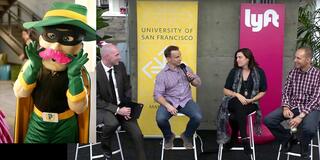6 Elements of a Thriving Startup Culture

Why would top tech execs take the risk of leaving Google for a startup that no one had ever heard of? The answer, as discussed in a recent USF School of Management panel at rideshare giant Lyft’s 66,000-square-foot headquarters in San Francisco’s Mission District, may be startup culture.
The panel included Ron Storn, VP of People at Lyft and USF alumnus, Claire Hughes Johnson, COO at Stripe and Michael DeAngelo, Head of People at Pinterest. Neil Walshe, a USF professor of organizational behavior and an expert on morality and virtue in organizational life, was the moderator.
The crowd of over 200 hundred at Lyft’s quirky office—decorated on brand with its pink beanbags and shaggy wallpaper—included USF students, faculty and alumni, employees from Lyft, Pinterest and Stripe and USF’s very own mascot, Don Francisco.
Throughout the hourlong panel, Walshe’s talk with the three tech executives homed in on the interplay between values and culture. Their conversation yielded great insight for people new to the job market, or those revisiting what type of company they want to work for. Here’s a sneak peek of what to expect when landing—or hoping to land—a position within a startup company.
6 Elements of a Thriving Startup Culture
- Get scrappy.
Storn, who leads recruiting, human resources and facilities at Lyft, calls out a few aspects of the company’s culture as key to their business success. One of the most important--scrappiness.
He defines “scrappy” as creatively tackling obstacles and not allowing any roadblocks, large or small, to get in the way or slow down their processes. In his opinion, a willingness to get scrappy is crucial at growing startups. “Having that mindset will help get any company to where they want to be.” - The team that lunches together, thrives together.
Stripe, a payment platform for mobile apps, values communal lunch time. Each day, all employees gather around together at the same time for their midday meal—a culture hack designed to help staff build one-on-one relationships.
Across long lunch tables, Stripe employees mingle and socialize in hopes of familiarizing themselves with each other so they can work better as a team, rather than as a group of acquaintances. Additionally, there is no cleaning crew. They don’t just eat together—they clean up together. - Lend a helping hand.
Stripe is proud to have systems in place encouraging each employee to help anyone with anything, no matter what one’s job description may be.
For example, when the receptionist is out of town or on a break, Stripe’s CEO and founder steps in the most out of all employees to cover the shift at the front desk. “It’s a great message and very much what Stripe is about,” said Johnson. Having all employees help in every position creates a dynamic where everyone can relate to each other more easily.
Both DeAngelo and Storn claimed that one attraction they had when considering career changes was the humbleness present within the founders of both Pinterest and Lyft, a trait that may be especially visible in more transparent startup cultures. - Feel at home, at work.
At Lyft it is very simple—they want everyone to be themselves. “Who you are at home is who we want you to be here,” said Storn. Which means that every day is bring your dog to work day.
Kimiye Ihara, an online marketing analyst at Lyft and USF MSEM/MBA ‘14 dual degree program alumna, says,
Working at Lyft, I think the best thing that I love is the company culture. One of the biggest things that I totally love when I come to work every day is bringing my dog; it’s something that makes me really happy.” - Self-awareness first; change second.
One strategy that Johnson implemented upon her arrival at Stripe was creating a group exercise of writing down the company’s current values. “The mistake I think some companies make is writing down aspirational values, versus being self-aware. A lot of our process was about writing down what was already true in the company.”
That doesn’t mean goals can’t be set, but it shows the importance in understanding the way a company culture works before anything else. Once it is known how a company’s values are already reflected in its culture, then necessary changes may be possible. - Diverse culture = creative product
The hiring and onboarding process is very crucial to these companies, because the people they add to their organizational rosters will ultimately affect their company culture and work environment.
Specifically, DeAngelo says that at Pinterest, they try to match their current culture with their desired future culture by encouraging diversity so that their product accommodates a wide variety of creative expression. “We’ve been really cautious with managers to manage unconscious bias,” he says, meaning that the ones who do the hiring are trained to lessen the unconscious biases that might naturally arise when interviewing potential employees.
Lyft, Stripe and Pinterest aim to place a high priority on cultivating company culture—and the panelists at USF’s event explained it is a major reason each of them personally made such risky career shifts to the startup side. They have all successfully helped strategize how to maintain a type of work environment that employees are able to thrive in, and in so doing, reaching a level to which all new startups hope to rise.
By Brandi Licciardo


